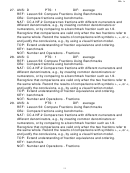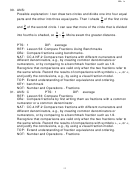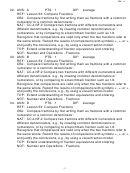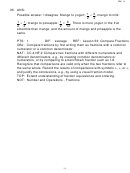Math Practice Test Page 26
ADVERTISEMENT
ID: A
27. ANS: D
PTS: 1
DIF: average
REF: Lesson 52: Compare Fractions Using Benchmarks
OBJ: Compare fractions using benchmarks.
NAT: CC.4.NF.2 Compare two fractions with different numerators and
different denominators, e.g., by creating common denominators or
numerators, or by comparing to a benchmark fraction such as 1/2.
Recognize that comparisons are valid only when the two fractions refer to
the same whole. Record the results of comparisons with symbols >, =, or <,
and justify the conclusions, e.g., by using a visual fraction model.
TOP: Extend understanding of fraction equivalence and ordering.
KEY: benchmark
NOT: Number and Operations - Fractions
28. ANS: C
PTS: 1
DIF: average
REF: Lesson 52: Compare Fractions Using Benchmarks
OBJ: Compare fractions using benchmarks.
NAT: CC.4.NF.2 Compare two fractions with different numerators and
different denominators, e.g., by creating common denominators or
numerators, or by comparing to a benchmark fraction such as 1/2.
Recognize that comparisons are valid only when the two fractions refer to
the same whole. Record the results of comparisons with symbols >, =, or <,
and justify the conclusions, e.g., by using a visual fraction model.
TOP: Extend understanding of fraction equivalence and ordering.
KEY: benchmark
NOT: Number and Operations - Fractions
29. ANS: A
PTS: 1
DIF: average
REF: Lesson 52: Compare Fractions Using Benchmarks
OBJ: Compare fractions using benchmarks.
NAT: CC.4.NF.2 Compare two fractions with different numerators and
different denominators, e.g., by creating common denominators or
numerators, or by comparing to a benchmark fraction such as 1/2.
Recognize that comparisons are valid only when the two fractions refer to
the same whole. Record the results of comparisons with symbols >, =, or <,
and justify the conclusions, e.g., by using a visual fraction model.
TOP: Extend understanding of fraction equivalence and ordering.
KEY: benchmark
NOT: Number and Operations - Fractions
11
ADVERTISEMENT
0 votes
Related Articles
Related forms
Related Categories
Parent category: Education
 1
1 2
2 3
3 4
4 5
5 6
6 7
7 8
8 9
9 10
10 11
11 12
12 13
13 14
14 15
15 16
16 17
17 18
18 19
19 20
20 21
21 22
22 23
23 24
24 25
25 26
26 27
27 28
28 29
29








